Rebecca Lo finds out how HK architects are trying to pursue the goal of making office and residential buildings virus-proof in the wake of the pandemic.
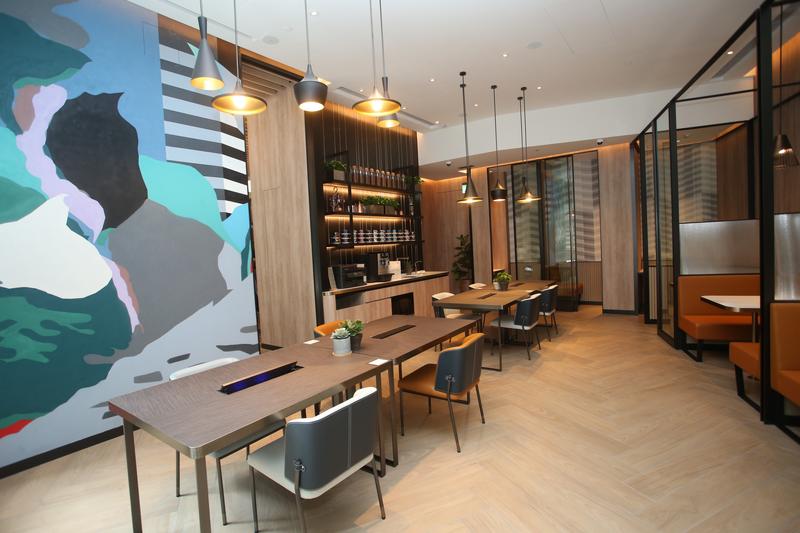 Residents of Townplace Soho can use the indoor communal space to work from home. (PHOTO PROVIDED TO CHINA DAILY)
Residents of Townplace Soho can use the indoor communal space to work from home. (PHOTO PROVIDED TO CHINA DAILY)
People around the world have spent much of 2020 hunkered down at home. Those looking to return to work have legitimate concerns about the risks of catching a viral infection in a shared space.
It is well documented that COVID-19 spreads through viral residue on surfaces, direct transmission through sneezing or coughing by those infected, and viral airborne particles. While personal hygiene addresses the first mode of transmission and social distancing the second, the third is the most difficult to pin down.
“Of the three, airborne transmission is now understood to pose the greatest risk,” says Greg Pearce of design firm One Space. Pearce has conducted webinars and presented papers on the subject. He feels, in order to restore trust in the built environment, seamlessly integrated protection needs to be a natural part of the user’s experience.
“Practically speaking, two things remain that we can do in building design to reduce airborne contamination risk: redefining the purpose of gathering in buildings and re-conceive buildings as living organisms,” Pearce states. “The reasons that workers go to the office have shifted — rather than solo desk work, it is a place to go when staff needs to connect with colleagues.”
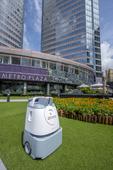 A cleaning robot at work on the lawns of Metro Plaza. (PHOTO PROVIDED TO CHINA DAILY)
A cleaning robot at work on the lawns of Metro Plaza. (PHOTO PROVIDED TO CHINA DAILY)
Visible intent
Before the emergence of COVID-19, work from home had not caught on in Hong Kong, primarily because of the small size of the living units in the city. Now, after a year of working from home, the tables have turned and employees need assurance that they are well-protected against health hazards in the workplace before they could be persuaded to return.
Convincing staff members that the office is a safe space will entail continuing social distancing practices, says Peter Basmajian of Richards Basmajian, an interior design firm. He advocates reconsidering planning and managing parameters for both new and existing premises.
“Temperature taking points, frequency of hand sanitizing stations, and spacing of workstations with screens between staff are all within the realm of planning and design,” Basmajian states.
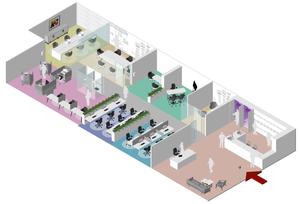 A drawing of a post-COVID-19 workspace, as imagined by One Space architects. (PHOTO PROVIDED TO CHINA DAILY)
A drawing of a post-COVID-19 workspace, as imagined by One Space architects. (PHOTO PROVIDED TO CHINA DAILY)
“Many firms do seem to be downsizing, partly due to a less than effervescent economy and partly due to the fact that working from home does seem to work — at least for some employees,” Basmajian notes. “This may not be true in the long term, however, because we are social animals and there is a sense of collaboration, teamwork and camaraderie to be gained from being together with workmates in an office setting.”
Truddy Cheung, real estate services firm Colliers’ director of Workplace Advisory Asia, agrees that measures already in place will continue to instill trust in building users. These include “access to flex spaces such as co-working spaces, increase of touchless access devices and social distance measures, alongside limiting capacity in all public spaces,” she notes.
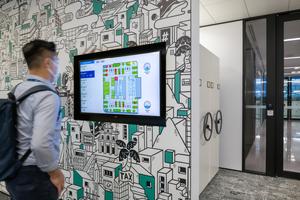 One Space’s design for KPMG allows employees to choose between sitting in a cluster and separate from others. (PHOTO PROVIDED TO CHINA DAILY)
One Space’s design for KPMG allows employees to choose between sitting in a cluster and separate from others. (PHOTO PROVIDED TO CHINA DAILY)
Further, promoting peace of mind for users is vital through “visible sanitization and disinfection communicated regularly and apps with timely communication to broadcast live pandemic updates,” Cheung advises.
“It is important to acknowledge that the science about the virus and the fear that surrounds the pandemic are not always aligned,” Pearce admits. “Both need to be addressed through the buildings and spaces we design and operate.”
His experience with clients and within his own company shows that transparent messaging involving all affected stakeholders goes a long way. Most employers have a genuine interest in ensuring staff welfare, which is evident in the visibly high standards of hygiene they try to maintain.
 One Space co-founder Greg Pearce says nowadays people visit their offices to connect with colleagues rather than work solo. (PHOTO PROVIDED TO CHINA DAILY)
One Space co-founder Greg Pearce says nowadays people visit their offices to connect with colleagues rather than work solo. (PHOTO PROVIDED TO CHINA DAILY)
Smart tech devices
Besides employers, real estate developers too are trying to ensure that existing and new buildings are up to snuff.
“Developers will likely face greater scrutiny about their buildings’ infrastructure,” predicts Pearce. “For example, air conditioning systems can be fitted with UV-C wavelength disinfection devices.”
Hong Kong developer Sun Hung Kai Properties has proactively responded to the needs of tenants during the pandemic. For its new residential developments, St Martin and Townplace Soho, work from home features such as robust wired and wireless information technology infrastructure have been integrated. To address the social and business needs of tenants, the developments offer versatile clubhouses, open spaces and gardens.
 Ensuring employees’ peace of mind is key, says Truddy Cheung, Colliers’ director of Workplace Advisory Asia. (PHOTO PROVIDED TO CHINA DAILY)
Ensuring employees’ peace of mind is key, says Truddy Cheung, Colliers’ director of Workplace Advisory Asia. (PHOTO PROVIDED TO CHINA DAILY)
SHKP has further ramped up its al fresco offerings in its shopping malls, addressing many families’ desire for healthier outdoor experiences during the pandemic. These include an outdoor urban farm and children’s play area at YOHO Mall and an outdoor balance bike park at New Town Plaza.
Since the beginning of the pandemic, SHKP has also raised hygiene standards in its existing properties. Alongside upgrade of its ventilation systems, the developer has installed contactless features such as automatic entry doors and touchless elevator call buttons. Intelligent cleaning robots for deep cleansing and disinfection have been pressed into service, and height sensors in mall waste bins send out disposal requests when full. Anti-bacterial nano coatings on concierge desks, ion air purifiers in elevators and ultraviolet sterilizers in malls further enhance hygiene standards.
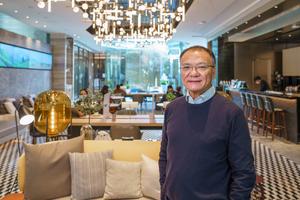 Mike Wong, deputy managing director, Sun Hung Kai Properties, says the smart technologies installed in their premises will outlast the pandemic. (PHOTO PROVIDED TO CHINA DAILY)
Mike Wong, deputy managing director, Sun Hung Kai Properties, says the smart technologies installed in their premises will outlast the pandemic. (PHOTO PROVIDED TO CHINA DAILY)
“COVID-19 has changed how people work, live, and consume,” says Mike Wong, deputy managing director with SHKP. “To cope with the new normal, we have widely adopted innovative designs and smart technologies to make our premises cleaner, safer and more intelligent. These changes will outlast the pandemic as the comfort and health of our customers, tenants and colleagues remain our top priority.”
Pearce believes that going forward, office buildings will transform into a new animal: a “comprehensive destination, mixed-use microclimate that provide flexible, safe and accessible facilities for meeting, gathering, sharing, collaborating and socializing with our colleagues. In Asian cities, we can foresee a shift away from the traditional landlord/tenant relationship toward that of a service provider/customer one. This would align landlords with occupiers toward satisfying the user experience that more discerning tenants seek — with a focus, of course, on health and well-being.”


